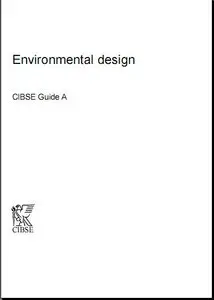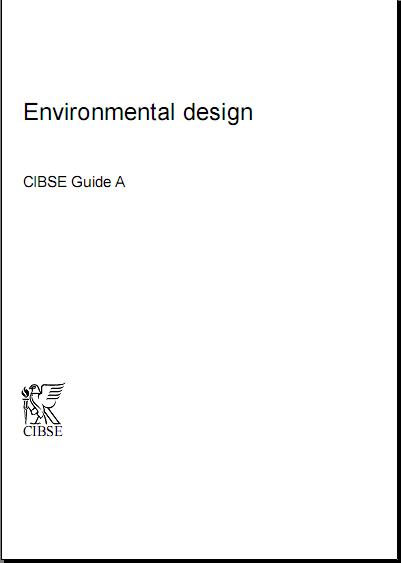Environmental Design (CIBSE Guides)
Chartered Institution of Building Services Engineers | 1999-10 | ISBN 0900953969 | PDF | Pages 336 | 2.98 MB
This sixth edition of Guide A contains significant changes from the previous edition. The
review of the whole range of topics covered by the volume, during a period when traditional
design criteria and calculation methods were being reconsidered, resulted in an iterative
process of revision, the consequence of which was a series of sectional drafts which were not
always compatible. The task of bringing these together into a coherent single volume has
contributed to the delayed publication of this Guide. The Institution has recently reviewed
and amended its publications strategy to ensure that this and other major Guides are
updated on a rolling programme, so that similar delays will not occur in future.
I would like to take this opportunity of thanking Institution members for their forbearance
with the delay and commend this new edition to them. It provides the basis for selecting
comfort criteria, along with the data and calculation methods required for good practice
design. As a learned society, the Institution is recognised as the authoritative body in the
theory and practice of building services engineering and the CIBSE Guide is often used in
litigation as the foundation for resolving disputes concerning professional practice.
The changes made in the sixth edition, compared to the fifth, can be briefly summarised, as
follows:
— Section 1: Environmental criteria for design covers the same basic topics of
temperature, humidity, lighting and acoustics, as did the previous edition, but each
has been extensively revised to provide more comprehensive data and
recommendations for particular situations. The most significant change has been to
replace the notion of a single ‘comfort’ temperature by summertime and wintertime
temperature ranges, based on percentage mean vote (PMV). Also, new sections have
been added dealing with indoor air quality, air filtration strategy and the
electromagnetic and electrostatic environment.
— Section 2: External design data replaces the former section A2: Weather and solar
data. The cold and warm weather data for the UK have been fully revised using
meteorological provided by the Meteorological Office for the period 1976-1995,
with detailed data for eight locations being included. The information is provided
in a form that allows the external design limit conditions to be selected by the
designer to meet the client’s requirements regarding design risk. A selection of
international heating and cooling design temperatures is included, drawn from data
published by ASHRAE. These data are reproduced by kind permission of
ASHRAE. Detailed solar data have been included for three UK locations, London
area (Bracknell), Manchester (Aughton) and Edinburgh (Mylnefield). Tables of
predicted irradiances for latitudes 0–60°N/S, based on computer algorithms, are
also included. For reasons of space, some of these data are located on the computer
disk that accompanies this Guide.
— Section 3: Thermal properties of building structures. This section is cited in Part L of
the Building Regulations as one of the accepted means of complying with the
regulatory requirements concerning the conservation of fuel and power. It has been
fully revised and expanded and now includes more detailed calculation procedures
to deal with the various types of window frame and glazing. Many of the relevant
national, European and international standards have been, or are currently being
revised and great efforts have been made to ensure that the calculation procedures
given in the Guide are consistent with these standards. The tables of thermal
properties of materials have been substantially increased, drawing from research
undertaken by the Building Environmental Performance Analysis Club.
— Section 4: Air infiltration and natural ventilation explores the mechanisms of
infiltration and natural ventilation, the forces creating these phenomena and
methods for calculating infiltration and ventilation rates. A computer program
listing is provided for calculating air change rates in single zone enclosures. This is
reproduced by the kind permission of the Air Infiltration and Ventilation Centre.
This section takes account of guidance contained in CIBSE Applications Manual
AM10: Natural ventilation in non-domestic buildings.
— Section 5: Thermal response and plant sizing brings together the subject areas formerly
covered in three separate Guide sections, i.e. A5: Thermal response of buildings, A8:
Summertime temperatures in buildings and A9: Estimation of plant capacity, and
provides a more coherent exploration of these topics. The new section considers a
range of calculation procedures, from simple steady-state heat losses and the
estimation of summertime temperatures through to computer-based dynamic
modelling. The admittance procedure is retained as a simple dynamic model,
suitable for application at an early stage in the design process. Guidance is provided
on which methods are suitable for particular applications and examples of their use
are given. This section also includes the data and equations necessary to apply the
various models.
Cooling load tables are provided for three UK locations, London, Manchester and
Edinburgh. These are based on the measured solar irradiances given in Section 2.
Similar tables provide estimated cooling loads for latitudes 0–60°N/S, based on the
predicted solar irradiances given in Section 2. These are included on the computer
disk that accompanies this Guide. Various appendices provide detailed derivations
of the equations and calculation techniques presented in the section.
— Section 6: Internal heat gains replaces section A7 of the fifth edition, which had the
same title. The section has been comprehensively revised and includes data for a
much wider range of equipment and systems, including computers and office
machines. Guidance is given on diversity factors and on the division of heat gains
into their radiant and convective components.
— Section 7: Moisture transfer and condensation. This replaces section A10 of the
previous edition of Guide A. While the calculation procedures have been retained
largely unchanged, the explanatory text has been revised and expanded and new
example calculations have been added. Tables of resistivities for common building
materials are now contained in Section 3.
The Institution appreciates the importance of its publications to its members’ day-to-day
activities. Guide A is accepted as the foundation for professional practice and applications
in building services engineering and it is therefore in all our interests that it is kept up-todate.
In order to do this, the Institution needs the help of CIBSE members and other users
of the Guide to identify areas where the present guidance is inadequate or needs to be
improved. The Institution will shortly start work on the seventh edition of Guide A and
members’ input is essential to its success. A time scale of three to five years is envisaged for
its preparation and the CIBSE Publications Department would be pleased to hear from
users of the Guide, both members and non-members, who feel that they can contribute to
this work.
Finally, having mentioned the importance of members’ views for future editions, I must
express my sincere thanks to the authors and contributors to this sixth edition of Guide A.
They include CIBSE members, some non-members and the staff at CIBSE, to all of whom
the Institution and I are extremely grateful.



